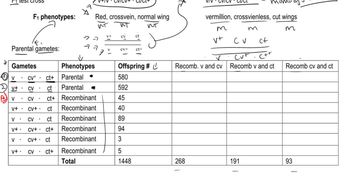The following table shows data from a cross examining three genes (a, b, and c). Calculate the recombination frequency for A and C
Table of contents
- 1. Introduction to Genetics51m
- 2. Mendel's Laws of Inheritance3h 37m
- 3. Extensions to Mendelian Inheritance2h 41m
- 4. Genetic Mapping and Linkage2h 28m
- 5. Genetics of Bacteria and Viruses1h 21m
- 6. Chromosomal Variation1h 48m
- 7. DNA and Chromosome Structure56m
- 8. DNA Replication1h 10m
- 9. Mitosis and Meiosis1h 34m
- 10. Transcription1h 0m
- 11. Translation58m
- 12. Gene Regulation in Prokaryotes1h 19m
- 13. Gene Regulation in Eukaryotes44m
- 14. Genetic Control of Development44m
- 15. Genomes and Genomics1h 50m
- 16. Transposable Elements47m
- 17. Mutation, Repair, and Recombination1h 6m
- 18. Molecular Genetic Tools19m
- 19. Cancer Genetics29m
- 20. Quantitative Genetics1h 26m
- 21. Population Genetics50m
- 22. Evolutionary Genetics29m
4. Genetic Mapping and Linkage
Trihybrid Cross
Problem 12
Textbook Question
Three gene pairs located on separate autosomes determine flower color and shape as well as plant height. The first pair exhibits incomplete dominance, where the color can be red, pink (the heterozygote), or white. The second pair leads to personate (dominant) or peloric (recessive) flower shape, while the third gene pair produces either the dominant tall trait or the recessive dwarf trait. Homozygous plants that are red, personate, and tall are crossed to those that are white, peloric, and dwarf. Determine the F₁ genotype(s) and phenotype(s). If the F₁ plants are interbred, what proportion of the offspring will exhibit the same phenotype as the F₁ plants?
 Verified step by step guidance
Verified step by step guidance1
Identify the genotypes of the parental plants based on the given traits and inheritance patterns. For the first gene pair with incomplete dominance (flower color), assign RR for red (homozygous dominant) and WW for white (homozygous recessive). For the second gene pair (flower shape), use PP for personate (dominant homozygous) and pp for peloric (recessive homozygous). For the third gene pair (plant height), use TT for tall (dominant homozygous) and tt for dwarf (recessive homozygous). Thus, the red, personate, tall parent is RR PP TT, and the white, peloric, dwarf parent is WW pp tt.
Determine the F₁ genotype by crossing the two homozygous parents. Since each parent is homozygous for each gene, all F₁ offspring will be heterozygous for each gene pair: RW for color, Pp for shape, and Tt for height. Write the F₁ genotype as RW Pp Tt.
Describe the F₁ phenotype based on the genotypes and inheritance patterns. For incomplete dominance in color, RW results in pink flowers. For flower shape, Pp results in personate flowers (dominant trait). For height, Tt results in tall plants (dominant trait). So, the F₁ phenotype is pink, personate, and tall.
To find the proportion of F₂ offspring (from F₁ interbreeding) that exhibit the same phenotype as the F₁ plants, analyze each gene separately. For incomplete dominance (color), the heterozygote RW shows pink flowers. For flower shape and height, the dominant phenotype appears in both homozygous dominant and heterozygous genotypes.
Calculate the probability for each trait to show the F₁ phenotype in the F₂ generation: For color, the heterozygous RW genotype frequency is 1/2 (from RW x RW cross). For flower shape, the dominant phenotype frequency (PP or Pp) is 3/4. For height, the dominant phenotype frequency (TT or Tt) is also 3/4. Multiply these probabilities to get the overall proportion of F₂ offspring with the same phenotype as the F₁ plants.
 Verified video answer for a similar problem:
Verified video answer for a similar problem:This video solution was recommended by our tutors as helpful for the problem above
Video duration:
2mPlay a video:
Was this helpful?
Key Concepts
Here are the essential concepts you must grasp in order to answer the question correctly.
Incomplete Dominance
Incomplete dominance occurs when the heterozygous genotype results in a phenotype that is intermediate between the two homozygous phenotypes. For example, crossing red (RR) and white (WW) flowers produces pink (RW) offspring. This differs from complete dominance, where one allele completely masks the other.
Recommended video:
Guided course

Variations on Dominance
Mendelian Inheritance of Independent Genes
Genes located on separate autosomes assort independently during gamete formation, following Mendel's law of independent assortment. This means the inheritance of one gene pair does not affect the inheritance of another, allowing for the prediction of combined genotypes and phenotypes using Punnett squares.
Recommended video:
Guided course

Gamete Genetics and Independent Assortment
Genotypic and Phenotypic Ratios in Dihybrid and Trihybrid Crosses
When multiple gene pairs are involved, the genotypic and phenotypic ratios can be calculated by considering each gene pair separately and then multiplying probabilities. For traits with different dominance patterns, such as incomplete dominance and complete dominance, the resulting offspring ratios reflect these inheritance modes.
Recommended video:
Guided course

Trihybrid Cross
Related Videos
Related Practice
Multiple Choice
961
views
4
rank
1
comments


